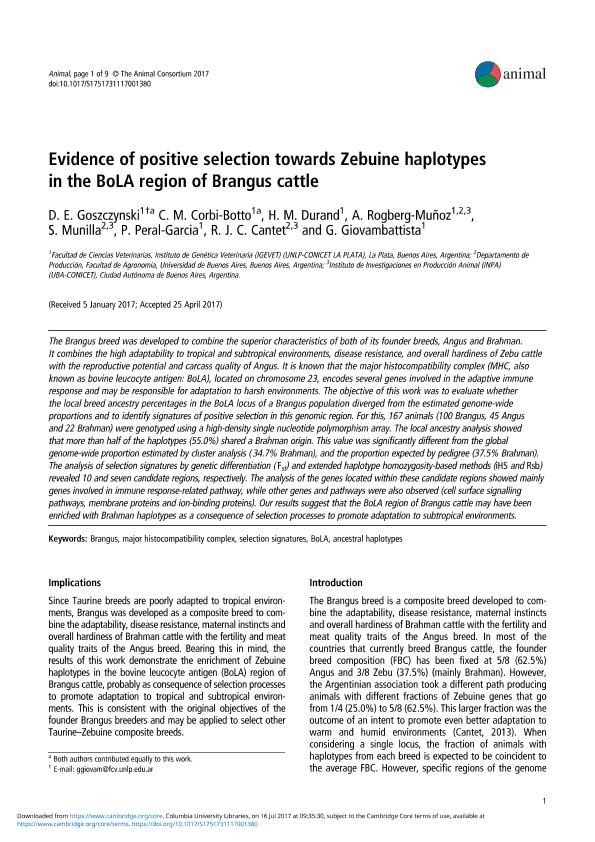Artículo
Evidence of positive selection towards Zebuine haplotypes in the BoLA region of Brangus cattle
Goszczynski, Daniel Estanislao ; Corbi Botto, Claudia Malena
; Corbi Botto, Claudia Malena ; Durand, H. M.; Rogberg Muñoz, Andres
; Durand, H. M.; Rogberg Muñoz, Andres ; Munilla Leguizamon, Sebastian
; Munilla Leguizamon, Sebastian ; Peral Garcia, Pilar
; Peral Garcia, Pilar ; Cantet, Rodolfo Juan Carlos
; Cantet, Rodolfo Juan Carlos ; Giovambattista, Guillermo
; Giovambattista, Guillermo
 ; Corbi Botto, Claudia Malena
; Corbi Botto, Claudia Malena ; Durand, H. M.; Rogberg Muñoz, Andres
; Durand, H. M.; Rogberg Muñoz, Andres ; Munilla Leguizamon, Sebastian
; Munilla Leguizamon, Sebastian ; Peral Garcia, Pilar
; Peral Garcia, Pilar ; Cantet, Rodolfo Juan Carlos
; Cantet, Rodolfo Juan Carlos ; Giovambattista, Guillermo
; Giovambattista, Guillermo
Fecha de publicación:
07/2017
Editorial:
Cambridge University Press
Revista:
Animal
ISSN:
1751-7311
Idioma:
Inglés
Tipo de recurso:
Artículo publicado
Clasificación temática:
Resumen
The Brangus breed was developed to combine the superior characteristics of both of its founder breeds, Angus and Brahman. It combines the high adaptability to tropical and subtropical environments, disease resistance, and overall hardiness of Zebu cattle with the reproductive potential and carcass quality of Angus. It is known that the major histocompatibility complex (MHC, also known as bovine leucocyte antigen: BoLA), located on chromosome 23, encodes several genes involved in the adaptive immune response and may be responsible for adaptation to harsh environments. The objective of this work was to evaluate whether the local breed ancestry percentages in the BoLA locus of a Brangus population diverged from the estimated genome-wide proportions and to identify signatures of positive selection in this genomic region. For this, 167 animals (100 Brangus, 45 Angus and 22 Brahman) were genotyped using a high-density single nucleotide polymorphism array. The local ancestry analysis showed that more than half of the haplotypes (55.0%) shared a Brahman origin. This value was significantly different from the global genome-wide proportion estimated by cluster analysis (34.7% Brahman), and the proportion expected by pedigree (37.5% Brahman). The analysis of selection signatures by genetic differentiation (F st ) and extended haplotype homozygosity-based methods (iHS and Rsb) revealed 10 and seven candidate regions, respectively. The analysis of the genes located within these candidate regions showed mainly genes involved in immune response-related pathway, while other genes and pathways were also observed (cell surface signalling pathways, membrane proteins and ion-binding proteins). Our results suggest that the BoLA region of Brangus cattle may have been enriched with Brahman haplotypes as a consequence of selection processes to promote adaptation to subtropical environments.
Archivos asociados
Licencia
Identificadores
Colecciones
Articulos(IGEVET)
Articulos de INST.DE GENETICA VET ING FERNANDO NOEL DULOUT
Articulos de INST.DE GENETICA VET ING FERNANDO NOEL DULOUT
Articulos(INPA)
Articulos de UNIDAD EJECUTORA DE INVESTIGACIONES EN PRODUCCION ANIMAL
Articulos de UNIDAD EJECUTORA DE INVESTIGACIONES EN PRODUCCION ANIMAL
Citación
Goszczynski, Daniel Estanislao; Corbi Botto, Claudia Malena; Durand, H. M.; Rogberg Muñoz, Andres; Munilla Leguizamon, Sebastian; et al.; Evidence of positive selection towards Zebuine haplotypes in the BoLA region of Brangus cattle; Cambridge University Press; Animal; 12; 02; 7-2017; 215-223
Compartir
Altmétricas



